

Scala IDE for Eclipse Space. At the time of writing, the following facts hold true: Android applications are self-contained, there appears to be no way for users to deploy a shared library to a deviceThe scala library therefore needs to be embedded in every android application that uses itThe Scala nature can be successfully added to an ADT projectUsing ProGuard is *highly* desirable, to keep these apps to a manageable sizeThere is no usable1 eclipse builder for proguard that we can add to a hybrid Scala/ADT projectUsing the Android SDK to create an ant-based project from the command line yields the exact same project layout as using the eclipse plugin 1 Obfuscate4e and a couple of JavaME toolkits add ProGuard support, but not in a way that's suitable for our needs.
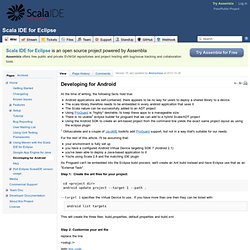
For the rest of this article, I'll be assuming that: As Proguard can't be embedded into the Eclipse build process, we'll create an Ant build instead and have Eclipse use that as an "External Task". Step 1: Create the ant files for your project: Step 2a: Test. Obtaining User Location. Note: The strategies described in this guide apply to the platform location API in android.location.
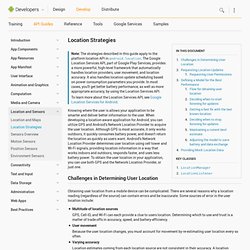
The Google Location Services API, part of Google Play Services, provides a more powerful, high-level framework that automatically handles location providers, user movement, and location accuracy. It also handles location update scheduling based on power consumption parameters you provide. In most cases, you'll get better battery performance, as well as more appropriate accuracy, by using the Location Services API. To learn more about the Location Services API, see Google Location Services for Android. Knowing where the user is allows your application to be smarter and deliver better information to the user. Challenges in Determining User Location Obtaining user location from a mobile device can be complicated. GPX: the GPS Exchange Format. What is GPX?
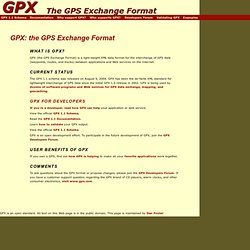
GPX (the GPS Exchange Format) is a light-weight XML data format for the interchange of GPS data (waypoints, routes, and tracks) between applications and Web services on the Internet. Current Status The GPX 1.1 schema was released on August 9, 2004. GPX has been the de-facto XML standard for lightweight interchange of GPS data since the initial GPX 1.0 release in 2002. GPX 1.1 Schema Documentation. GPX 1.0 Developer's Manual. This Manual is Outdated!
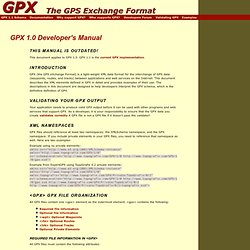
This document applies to GPX 1.0. GPX 1.1 is the current GPX implementation. Introduction GPX (the GPS eXchange Format) is a light-weight XML data format for the interchange of GPS data (waypoints, routes, and tracks) between applications and web services on the Internet. This document describes the XML elements defined in GPX in detail and provides examples of their use. GPS Data. From Processing This page presents a Processing library to help you read and manipulate GPS data in the GPX format.
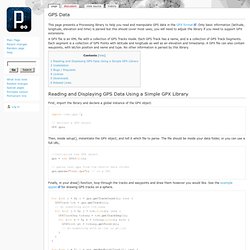
Only basic information (latitude, longitude, elevation and time) is parsed but this should cover most uses; you will need to adjust the library if you need to support GPX extensions. A GPX file is an XML file with a collection of GPS Tracks inside. Each GPS Track has a name, and is a collection of GPS Track Segments. Each segment is a collection of GPS Points with latitude and longitude as well as an elevation and timestamp. First, import the library and declare a global instance of the GPX object. GPS eXchange Format. Google's Android OS: Past, Present, and Future. Thinking back, it's hard to believe that with so many Android phones on the market today, that the first version of the Android OS was released only 3 years ago, but the full story starts a few years earlier.
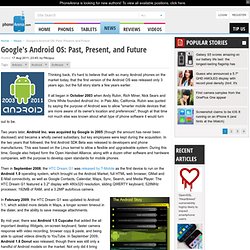
It all began in October 2003 when Andy Rubin, Rich Miner, Nick Sears and Chris White founded Android Inc. in Palo Alto, California. Rubin was quoted by saying the purpose of Android was to allow "smarter mobile devices that are more aware of its owner's location and preferences", though at that time not much else was known about what type of phone software it would turn out to be.
Two years later, Android Inc. was acquired by Google in 2005 (though the amount has never been disclosed) and became a wholly owned subsidiary, but key employees were kept during the acquisition. In the two years that followed, the first Android SDK Beta was released to developers and phone manufactures. This was based on the Linux kernel to allow a flexible and upgradeable system. Android Programming.
JFokus 2011: Android Application Development. Touchqode - Aplikacje w Android Market. Developers. Oracle shows off JavaFX on Android and iOS. Oracle this week showed JavaFX rich client software running on both an Apple iPad and an Android-based Samsung Galaxy tablet, along with introducing a separate project using HTML5 to bring Java to Apple's iOS platform, called Project Avatar.
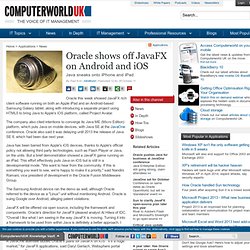
The company also cited intentions to converge its Java ME (Micro Edition) platform, which puts Java on mobile devices, with Java SE at the JavaOne conference. Oracle also said it was delaying until 2013 the release of Java SE 8, which had been due next year. Java has been barred from Apple's iOS devices, thanks to Apple's official policy not allowing third party technologies, such as Flash Player or Java, on the units.
But a brief demonstration showed a JavaFX game running on an iPad. This effort effectively puts Java on iOS but is still in a developmental mode. The Samsung Android device ran the demo as well, although Oracle referred to the device as a "Linux" unit without mentioning Android. Steve On Java - JavaFX » Visage Android – Cleaner APIs, Cleaner UIs. Android Development Tutorial. Nbandroid.org.